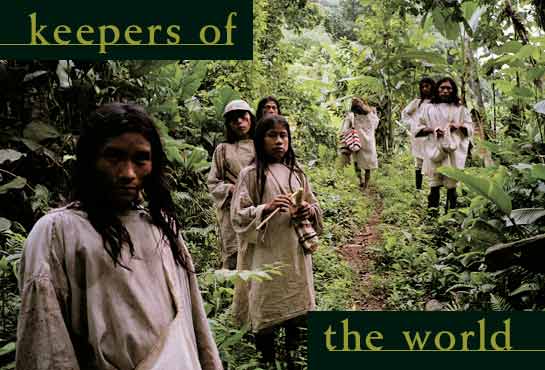Keepers of the World by Mayah .....
The Kogi, Arhuaco, and Wiwa peoples of the Sierra Nevada in Colombia continue to practice their earth-based spirituality, 500 years after the Spanish Conquest
Date: 1/16/2009 7:17:44 PM ( 15 y ago)

http://ngm.nationalgeographic.com/ngm/0410/feature3/
Introduction by Wade Davis
Text and photographs by Stephen Ferry
If they protect their sacred mountain home, the Indians of northern Colombia believe they will keep the entire planet in balance. It's getting more and more difficult.
In a bloodstained continent, the Indians of the Sierra Nevada de Santa Marta were never truly vanquished by the Spaniards. Descendants of an ancient South American civilization called the Tayrona and numbering perhaps 45,000 today, the Kogi, Arhuaco, and Wiwa peoples fled death and pestilence four centuries ago, seeking refuge in a mountain paradise, whose peaks soar more than 18,000 feet above the Caribbean coast of Colombia. In the wake of the conquest they developed an utterly new dream of the Earth, a revelation that balanced the baroque potential of the human mind and spirit with all the forces of nature.
Separated by language but closely related by myth and memory, they share a common way of life and the same fundamental religious convictions. (A fourth group, the Kankuamo, also found protection in the Sierra Nevada, but they have now become more assimilated into Colombian society.) To this day the Kogi, Arhuaco, and Wiwa remain true to their ancient laws—the moral, ecological, and spiritual dictates of the primordial creator, a force they identify as the Mother—and are still led and inspired by a ritual priesthood. In an arduous process of initiation that can take up to 18 years, young acolytes are taught the values of their society, among them the notion that their spiritual work alone maintains the cosmic (or as we might say, ecological) balance.
When the priests, or Mamas, speak, they immediately reveal that their reference points are not of our world. They refer to the Spanish conquest as if it were a recent event. They talk openly of the force of creation, or Se, the spiritual core of all existence, and aluna, human thought, soul, and imagination. What is important, what has ultimate value, is not what is measured and seen but what exists in the many realms of meanings and connections that lie beneath the tangible realities of the world, linking all things. The nine-layered universe of their cosmology, the nine-tiered temple where they gather, the nine months a child spends in its mother's womb are all expressions of creation, and each reflects and informs the other. A hill can also be a house, the mountains a model of the cosmos. The white hats worn by Arhuaco men also symbolize the snowfields of the sacred peaks. The hairs on a person's body echo the forest trees that cover the mountain flanks. Every element of nature is imbued with higher significance, so that even the most modest of creatures can be seen as a teacher, and every feature of the world mirrors the whole. —Wade Davis
Videos of the Kogi are fascinating and well worth watching: go to http://ngm.nationalgeographic.com/ngm/0410/feature3/# then click on "multimedia" . Be sure to watch the video produced by Kogi, Arhuaco, and Wiwa young men, specially selected by their elders to be the representatives of and spokesmen for their tribes.
VIDEO Stephen Ferry discusses the beliefs of the Indians of the Sierra Nevada, their relationship to their cosmos, and their concerns for the environment;
VIDEO Peer into the traditions and daily life of the Indians of the Sierra Nevada de Santa Marta in this self-recorded film, made possible by a grant from National Geographic's Expeditions Council.
Forum: What can be done to help indigenous people such as the Wiwa, Kogi, and Arhuaco live without interference from outsiders?
The indigenous peoples of Colombia's Sierra Nevada de Santa Marta have resisted contact with outsiders for centuries. Nevertheless, Spanish conquistadores, Christian missionaries, peasant farmers, and now armed fighters in Colombia's civil conflict have penetrated their land, destroying sacred ancestral sites and pushing Indians farther up the mountain.
In 1987—to counteract the encroachment and communicate concerns to the world—the Kogi, Arhuaco, and Wiwa groups formed an organization led by their spiritual leaders, or Mamas, to communicate with outsiders and exercise their indigenous rights enumerated in Colombia's constitution. The organization, called Gonawind˙a Tayrona Indigenous Organization of the Mamas, enables them to convey their unique indigenous philosophy on land and environmental matters to the rest of the world.
Gonawind˙a Tayrona actively negotiates with non-Indian settlers on the lower slopes of the massif, buying back ancestral Indian land so that the Indians can restore the natural jungle habitat, mending the ecological balance, and re-attracting animals like wild boars and birds. When the jungle grows back, Indians cultivate only small patches of the restored land in accordance with their belief system. With prayer and offerings, the Mamas conduct spiritual work to heal and revitalize these sites.
If you are interested in learning more about the organization and helping the Indians of the Sierra Nevada, contact the Gonawind˙a Tayrona
c/o Margarita Villafañe at:
Carrera 19A No. 23-05
Santa Marta, Colombia
The Indians have also created a website, http://www.tairona.org .
Popularity: message viewed 5551 times
URL: http://www.curezone.org/blogs/fm.asp?i=1337229
<< Return to the standard message view
Page generated on: 11/23/2024 4:37:22 AM in Dallas, Texas
www.curezone.org
